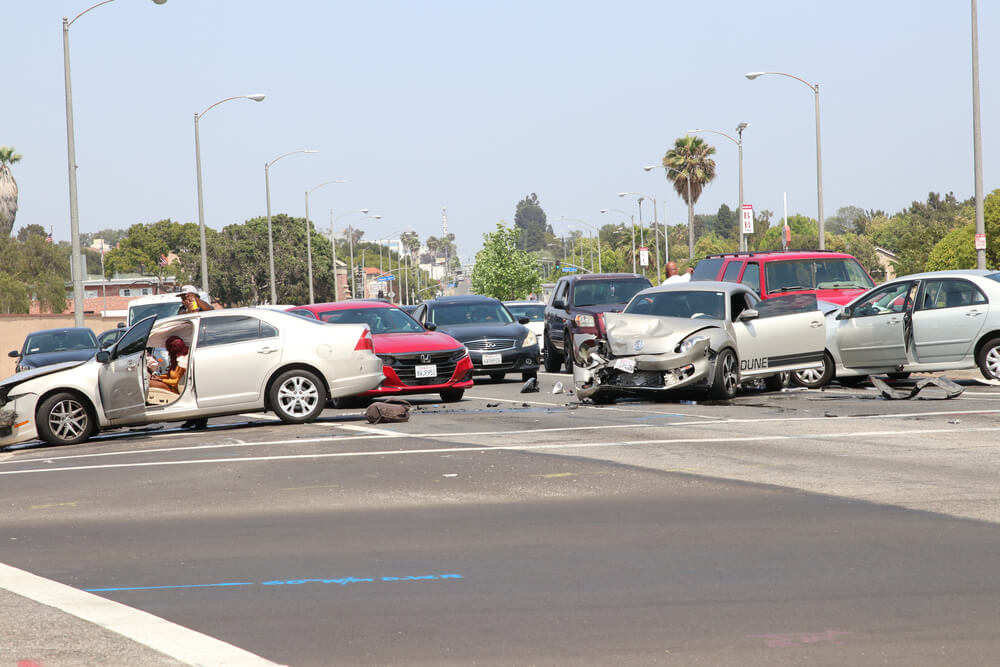When a car crash happens between two vehicles, it’s typically much easier to determine who’s at fault. If one driver is adhering to the rules of the road while the other is intoxicated and there’s an accident, it’s safe to assume the intoxicated driver is responsible.
However, in multi-vehicle crashes — a type of car accident involving three or more vehicles — it can be much harder to figure out who might be liable.
Here, we look at the different types of multi-vehicle crashes, who might be responsible, the common injuries sustained in these accidents, and what you should do if you’re in one.
Areas in Greater San Antonio We Serve
How Multi-Vehicle Crashes Happen
Multi-vehicle crashes can happen much in the same way as single-vehicle crashes or collisions between two cars. The factors that often contribute to multi-vehicle crashes include:
- Speeding
- Distracted driving, such as driving while texting
- Tailgating
- Road rage
- Driving while fatigued
- Drunk-driving
- Heavy traffic
- Road defects
- Inclement weather.
In most cases, multi-vehicle crashes caused by the above are entirely avoidable. Even when motorists are navigating tricky weather conditions such as heavy snow or rain, they are obligated to take care and slow down appropriately to minimize the crash risk.
Aside from these factors, different types of multi-vehicle crashes include:
Chain Reaction Multi-Vehicle Crashes
A chain-reaction crash happens when one vehicle crashes into another, causing another vehicle to crash into the wreckage, another vehicle, and so on. This type of crash often happens on roads with built-up traffic and results in a series of rear-end collisions, as the cars behind can’t react in time and have nowhere to go but into the back of the car ahead.
If a driver can break the chain, they may still end up crashing their car, such as if they swerve to avoid a rear-end collision, only to end up crashing into a wall or barrier.
Chain reaction crashes can result in a massive pile-up, which often results in many people getting injured.
Multi-Vehicle Lane Changes Caused by Improper Lane Changes
Improper lane changes are a frequent cause of car crashes and can just as easily involve multiple vehicles. If a driver believes they have right of way and veers onto another lane, they may T-bone a car, which might get hit by another.
Hit-and-Run Multi-Vehicle Crashes
A hit-and-run is an incident where a car strikes another — or a pedestrian — and escapes the scene, but they can involve more than two vehicles.
This can cause liability issues, as a driver may claim someone else was at the scene who caused the crash.
Common Injuries Sustained in Multi-Vehicle Crashes
Multi-vehicle crashes don’t just involve more people — they often cause more damage. For example, if you’re driving down the highway and the driver ahead suddenly brakes, causing you to rear-end them, you might sustain a head injury. But then, the driver behind you crashes into you, causing whiplash, and the chain reaction causes more severe injuries with every additional shunt.
Some of the common injuries those in multi-vehicle crashes experience are:
- Traumatic brain injuries
- Broken bones
- Whiplash and other neck or back injuries, including spinal cord injuries
- Burn injuries
- Internal bleeding
- Dental and facial injuries
- Cuts and lacerations.
Who’s Liable for a Multi-Vehicle Accident?
Because multiple vehicles are involved in this type of car crash, determining who is liable can be more complex than a cut-and-dry incident between two individuals where one is clearly responsible.
One driver may be responsible for the crash, or drivers may share the blame. Sometimes, liability may fall on a third party, such as a manufacturer.
Let’s look at a couple of examples:
Example 1: A Multi-Vehicle Chain Reaction Crash
The main question in determining liability in a chain reaction crash is whether one individual could have done something differently to reduce the accident’s impact.
For example, if Driver A hits Driver B, which causes Drivers C and D to crash too, is Driver A at fault for the entire accident, or could Driver B be partly responsible?
The unfortunate answer is that it depends.
If Driver A abruptly stopped the car and there was nothing any other drivers involved in the crash could do differently, liability would likely lie with that driver.
However, if Driver B was checking their phone or tired when the accident happened, Driver B could also be responsible. Why? Because if they had their eyes on the road or weren’t driving while tired, they could have taken evasive action, and the impact wouldn’t have happened.
If you’re Driver B in this scenario, you may still be able to claim compensation even though you were partly at fault. This is because Texas has modified comparative negligence laws, which assert that as long as you are less than 51% at fault for the accident, you can still receive compensation. The percentage of fault is then deducted from your total settlement.
Again, to illustrate this with an example, if you are 20% at fault for the accident because you were fatigued, and your settlement totals $50,000, you would receive $40,000 ($50,000 minus 20%, or $10,000).
Example 2: A Multi-Vehicle Crash Involving a Hit-and-Run Driver
In any car accident, drivers are likely to blame each other. When someone asserts another driver caused the crash and then drove away, this can raise the question of whether there really was another driver or if it’s an attempt to deflect blame.
In any case, evidence is critical, but it becomes even more vital when the alleged driver wasn’t on the scene when police arrived.
Evidence that can help prove this claim includes witness testimony, including of other drivers involved in the crash, and traffic or security footage. Experts can also be called to reconstruct the scene based on the documented damage to vehicles to determine whether it was caused by another vehicle.
Example 3: A Multi-Vehicle Crash Caused by a Defect
As we’ve stated, drivers aren’t the only party that might be liable for a multi-vehicle crash. Auto defects are less common, but they happen, and the manufacturer of the defective part could be held liable.
For example, if Driver A changes lanes and Driver B hits the brakes, but they do not work due to a defect, causing Driver C to rear-end Driver B, the brake manufacturer may be at fault. If the brakes had functioned as intended, the accident may have been avoided.
In this case, a driver may still be responsible, such as if Driver A did not have right of way and, therefore, shouldn’t have changed lanes.
Proving liability in a multi-vehicle crash ultimately comes down to the strength of evidence, which makes it vital to consult a lawyer. Our Texas car accident lawyers can help you determine who’s at fault and call upon witnesses and experts to prove it.
What to Do if You’re in a Multi-Vehicle Crash
Immediately after a multi-vehicle crash, the first thing you should do is stay in your vehicle — as long as it is safe to do so — and call the police. If you have injuries, you could make them worse if you attempt to move from your car.
Once the police arrive, they’ll ask questions, which will form a crash report. This is vital evidence that explores what happened, who was involved, and the factors that contributed to the accident.
At this time, taking photographs of the scene and documenting your injuries and the information of anyone else involved or who witnessed the accident is also beneficial.
As soon as possible, you should seek medical treatment. Your health should be your top priority, so you should get checked out even if you feel fine and don’t have any immediately noticeable injuries.
Getting seen by a doctor is also crucial if you intend to claim compensation, as your medical records will support when and how your injuries occurred.
Then, you shouldn’t hesitate to speak to a personal injury lawyer. A lawyer can help you arrange treatment, postpone payment, and negotiate the best possible settlement.
Being in a multi-vehicle crash is a traumatic event, but you don’t have to suffer alone. Our car accident lawyers in McAllen and San Antonio can help you recover compensation for your medical expenses, lost wages from being unable to work, and pain and suffering. Call us 24/7 at 855-LAW-NINJA for a free, no-obligation case review and find out if you can claim.

